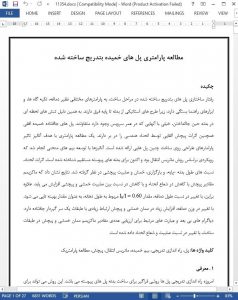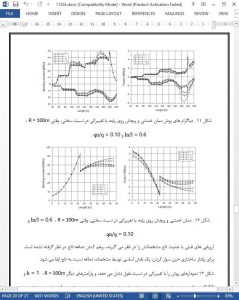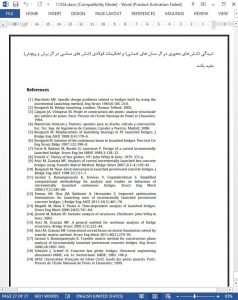Abstract
The structural behaviour of incrementally launched bridges in the construction stages depends on different parameters involving deck, nose, supports and guide devices, because static schemes vary continuously with the advance of the deck above the piers. For this reason temporary stresses in the deck, during launching, are rather different from those occurring in service life. Horizontally curved launched bridges also present the effects of torsion induced by geometric curvature. A parametric study is presented in order to analyse the influence of design parameters on the construction of these bridges. Analyses were carried out by extending to curved beams a procedure based on the Transfer Matrix Method, already known for straight continuous decks. Effects of curvature, nose–deck ratios of length and load, bending and torsional stiffness ratio were taken into account. The results show that maximum torsion values increase with the decrease in the curvature radius R and with the decrease in the ratio between bending and torsional stiffness. Moreover, with variation in the nose length ratio, the value ln/l = 0.60 with respect to the span length, is confirmed as the optimal value, as happens for straight bridges. With variation in the nose weight, a significant increase in bending moment and torsion can only be appreciated in the cantilever stages of launching. Dimensionless diagrams and related expressions are given for numerical evaluation of the maximum values of bending moment and torsion in the construction stages, with variation in the stiffness ratio and the radius of curvature.
1. Introduction
Incremental launching of bridges is nowadays a widespread methodology for the construction of continuous bridge decks. It can be applied both to concrete and steel bridge girders and it has the advantage of eliminating the traditional scaffolding to support formwork. This technology requires low investments in specialised equipments such as a launching nose, conventional jacks, launching jacks, temporary slide and guide devices. Deck segments are built in a concentrated working area, placed behind one of the abutments of the bridge, centralizing all concrete or steel construction activities. For concrete bridges, each segment is cast in contact with the previously completed part of the structure, and assembled to it through prestressing. By contrast, steel decks are directly assembled by joining segments with bolted or welded connections. The whole assembled girder is then advanced forward a distance equal to the last segment already built, releasing the working area for the construction of the new segment. The construction sequence is repetitive and may be organised to reach very efficient and high-quality workmanship [1].
5. Conclusions
A parametric study for the construction sequence of curved incrementally launched bridges was carried out. The procedure followed was based on the reduced transfer matrix method, already known in the literature for straight bridges and extended by the authors to curved continuous beams. From this parametric study, indications for the conceptual design of curved incrementally bridges can be obtained.
(1) Torsion shows its maximum and minimum values in the span just behind the nose and these values are very different from those occurring in the rest of the beam. An evaluation of tangential stresses due to shear and torsion, in concrete box sections, shows an increment of about 15–20% with respect to the case of the equivalent straight beam in which there is no torsion. This occurs in the span behind the nose, while the increment in tangential stresses is from 5% to 10% in the current sections of the beam. The highest torsion values are found with shorter lengths of launching nose.











